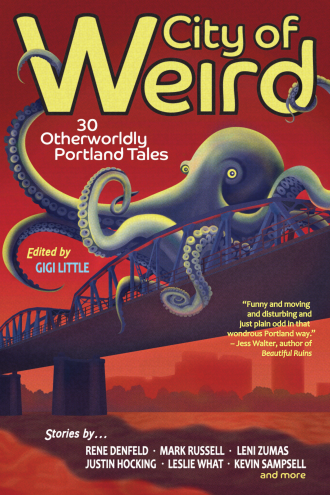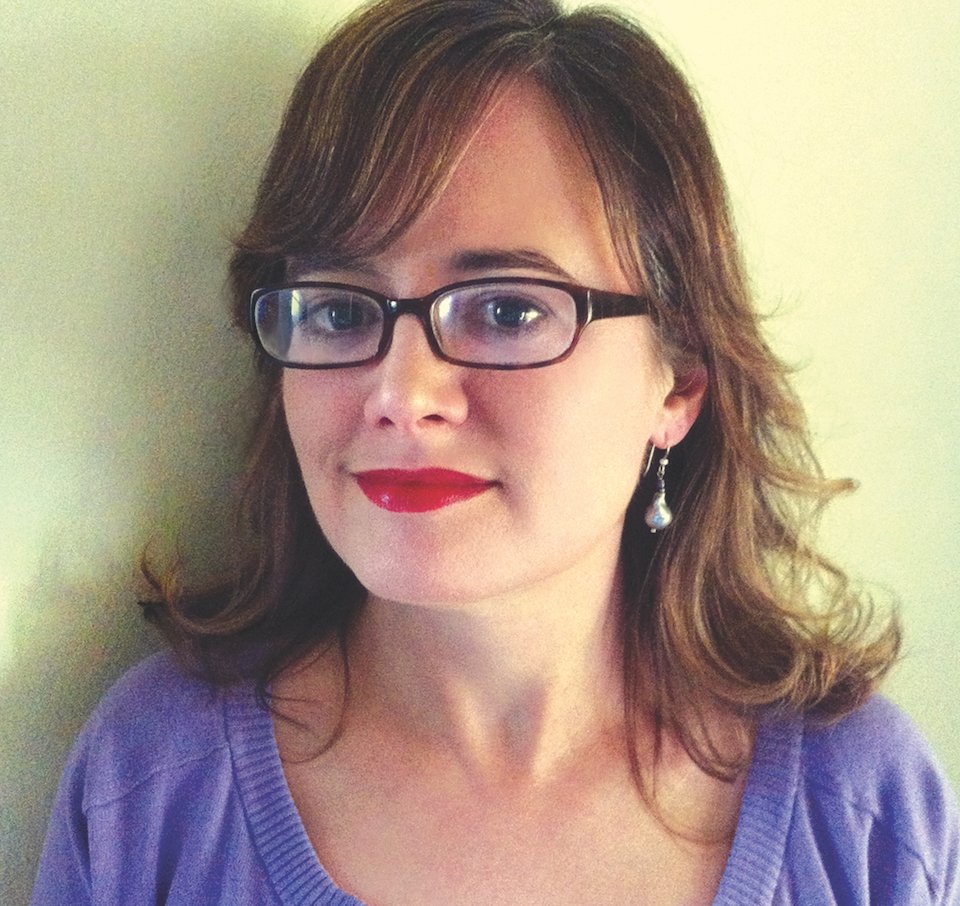Gigi Little

Gigi Little is the mad scientist behind City of Weird (Forest Avenue Press, 2016), a science fiction pulp anthology cloaking the natural environments of Portland in the supernatural themes of The Twilight Zone. Here, Little carefully edited a body of work that includes contributions by Kevin Sampsell, Rene Denfeld, Leslie What, and many other great Portland writers that found her suturing each writer’s story together as the curator. As the book’s cover designer, its fiendish exterior appreciates 1950s issues of Weird Magazine and pays homage to the city in equal parts. Each story expertly balances the weird with the literary in fun and unexpected ways. And while the stories are the heart of the book, Little’s massive imagination as the curator, editor, and designer are what give her monster anthology life.
Eleven: Let’s begin by discussing how you came up with City of Weird. How did you start developing your anthology conceptually?
Gigi Little: I was a big Twilight Zone kid, so I’ve been interested in stories like these since I was little. I am also the graphic designer for Forest Avenue Press, and I wanted to pitch them an anthology for a while. My first pitch was for a collection of stories all about the devil that took place in Portland, which was more zeroed-in topically. Laura, the publisher, thought that idea was interesting, but maybe that my concept was too narrow. I went back and asked myself, “What’s a fun topic that lots of people can write to, while also framing it around Portland?” I then came up with City of Weird as a fun tribute to the weirdness of Portland. I think submissions were happening around this time around two years ago, so it was a huge and long process.
 11: How would you describe City of Weird to a new reader?
11: How would you describe City of Weird to a new reader?
GL: My way of describing it is that it’s basically The Twilight Zone set in Portland. It’s all about monsters, ghosts, spacemen, and all those great Weird Tales tropes, only set in Portland. Some stories are just fun, and other stories delve into unexpected places, but it’s also a very literary book.
11: City of Weird contributors range from established authors like Kevin Sampsell, Rene Denfeld, and Leslie What to never before published writers. How did you find your contributors?
GL: We did open submissions through Submittable, but I also invited people I thought would be particularly good for this collection to contribute. I wanted a graphic novel type story, so I outright invited Jonathan Hill because I knew he would be perfect for the collection. However, when I put out the call for submissions, I said, “Picture the many-tentacled beasts that live under the Burnside Bridge, and that’s what I am looking for here.” We had people submit who wrote books and others who hadn’t been published before. It was cool. I read for about twelve months, so curating it was hard.
11: Can you talk about the curatorial process, and how you decided what to include in your anthology?
GL: Laura, the publisher, could see author bios and things like that, but I read all of the submissions blind, so I could only see the stories. At the time, I was in the Dangerous Writers Workshop, so I knew a number of those writers were going to submit. The blind somehow made it so that I wasn’t able to discern who the writers were, even though I knew their work and their voices. Once in awhile Laura would flag an author with diversity, because it was important for our collection to have a wide range of writers. But I just read, read, read, and I picked the stories that I really liked.
11: How did authorial experience affect the editorial process between editing a HarperCollins published author to a first time published writer?
GL: Every story was different. Some were close to being finished and others were where I would ask, “I love this, but what would you say about changing this huge thing?” I feel like I learned the most, personally, from editing Leigh Anne Kranz’s “Orca Culture,” which was her first published story ever. I would tell her, “I’m bumping on this thing, but something is bothering me about this passage.” We’d talk about it, and she’d carve out a tiny little word that made her piece perfect. I also had to edit Rene Denfeld, who wrote The Child Finder—great book, go read it! I had a lot of anxiety about editing her, but she was wonderful, as was everyone else. It was a great experience.
11: Can you talk about some of the challenges that went into the editorial process from a writer’s perspective?
GL: I’ve been on the other side for so long, whether in my other published work, in a workshop, or how I might take an editor’s criticism. Being on the other side was intimidating in a different way, because I didn’t know if I had the moxie or the guts to really mess with these peoples’ beautiful stories—I know how that feels! I tend to be a neurotic person, and I worried about what these writers were going to do once they saw my suggestions. Some writers love getting their work edited, while editing can hurt others. There were little things too. Like, I had at least two different stories that dealt with octopuses. I had octopi and octopuses, so we looked at The Chicago Manual of Style and it was octopuses there, so I had to tell people it wasn’t octopi. Little stuff like that felt intimidating.
11: Were there any takeaways from your experience as an editor?
GL: What makes a good editor is that you explain changes to the writer you edit. I learned a lot about communication. I explained everything I did. It took a lot of work. I probably took more time than most people because I spent so much time explaining what I did with their stories. I’d apologize about the amount of markups, but I wanted to explain to them with detail about what I was doing.
11: You also had to deal with organization…
GL: Yes. You have all of those little things like octopuses versus octopi, whether that person needs to be doing that thing, or how they say what. Then I had the big picture task of putting it together. I decided it would be in different parts, so I had to find themes. I made a whole section on dogs, a whole section on things that come up from the deep, along with many other parts. The organization part of it was so hard. Every single step of the way was hard and great.
11: Returning to octopuses, you not only curated and edited City of Weird, but you designed the cover as well. Did the design process have any impact on the content?
GL: Your question makes me realize that I was in a unique situation where I was doing both the editing and the design at the same time. I now wonder whether those two things informed each other. And I think they did, because all of the stories are present day and modern, but the cover and the illustrations were based on 1950s pulp magazines.
I think my vision for the cover was there even before I started taking the stories. Not necessarily the octopus, but that I would do a cover based on those old magazines and books from the 1950s. When I put out the call for submissions, I did it along with old pictures of Weird Tales, and Amazing Stories. That thing in my head that loves that old retro style effectively informed what I took through submissions. Not that the stories ended up being campy, or that they took place in the 1950s, but that there was something there that crossed over in the written content.
11: You are a writer, but you didn’t contribute a weird story of your own. How come?
GL: I wanted to, but that wasn’t on the table because it felt too insider for me to put my own story in there. I would love to write a story about a break in the space-time continuum happening at Stark’s Vacuum Museum, but I don’t know if I have the gumption to edit it all by myself. If I did, I’d submit my own story.
11: Is there any intention to make another City of Weird? Perhaps a City of Beard?
GL: I never thought of City of Beard, but I have thought of doing a second City of Weird that zeroes into something more specific like spacemen. We also thought of branching out to other cities like Austin for another book. City of Beards is actually pretty cool though!
11: City of Weird is doing very well in bookstores. How are you reacting to its success now going into its third pressing?
GL: Making money at all with a small press is nearly impossible. This book is helping provide wheels for the rest of the press, and that is the reason I proposed it in the first place. We are doing fabulous books at Forest Avenue, but I wanted to do something novel with this collection. The whole time I had this anxiety where I thought, “Guess what, it’s not going to sell and nobody is going to care.” But it did sell, and it still amazes me that it keeps selling! However, I think the best part about this whole experience for me is when writers call it “our book,” or “my book.” It is so amazing to hear them take ownership of it. Being a part of an anthology is all I ever wanted in my life. It took me until I was almost forty to get there, but I did it.




